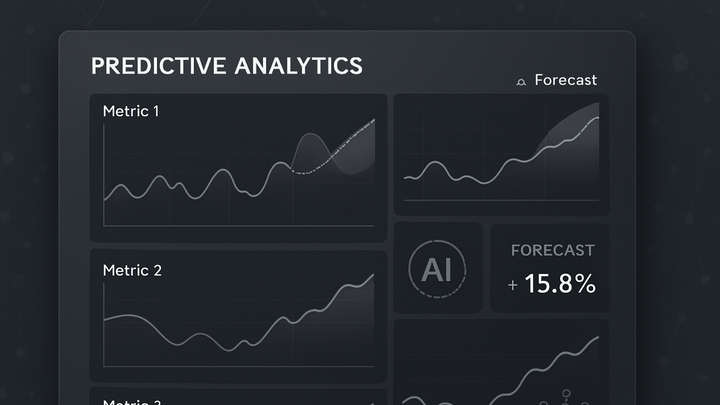Published on 2025-06-27T19:05:26Z
What are Predictive Metrics? Examples in Analytics
Predictive metrics are forward-looking indicators that leverage historical data and statistical models to forecast future outcomes. Unlike descriptive metrics, which tell you what happened, predictive metrics estimate what is likely to happen, enabling organizations to make proactive decisions. These metrics are rooted in advanced analytics, such as regression, time series, and machine learning. Predictive metrics help teams identify emerging trends, allocate resources efficiently, and mitigate potential risks. They serve as a critical component in strategic planning, marketing optimization, and risk management processes. Adopting predictive metrics transforms raw data into a strategic advantage by anticipating customer needs and market shifts.
Predictive metrics
Metrics that forecast future outcomes using historical data and ML models for proactive decision-making.
Why Predictive Metrics Matter
Predictive metrics provide a glimpse into future performance by analyzing past patterns. They empower businesses to stay ahead of market shifts rather than react after the fact. By converting raw data into forward-looking insights, teams can pivot strategies, optimize budgets, and manage risk proactively. In competitive industries, predictive metrics often distinguish leaders from laggards. Understanding their significance is the first step toward embedding analytics-driven foresight across your organization.
-
Proactive decision-making
Using predictive metrics, businesses can anticipate market shifts and customer behavior before they occur, allowing for timely adjustments in strategy and operations.
-
Forecast future demand
Analyze historical sales and traffic data to predict upcoming spikes or drops in customer demand.
-
Identify churn signals
Detect early warning signs of customer churn by monitoring engagement and purchase probability metrics.
-
-
Resource optimization
By forecasting performance indicators, organizations can optimize budget allocation, inventory levels, and staffing based on predicted needs.
-
Risk mitigation
Predictive metrics help identify potential risks, such as system outages or customer churn, enabling preemptive countermeasures.
Core Components of Predictive Metrics
At the heart of predictive metrics lie several key components that transform raw data into actionable forecasts. High-quality, well-prepared data is essential for accurate predictions. Statistical and machine learning models analyze patterns and correlations to generate predictive insights. Finally, performance indicators and confidence intervals quantify the reliability of these forecasts. Each component must be carefully designed and continuously refined to maintain the predictive power of the metrics.
-
Data quality and preparation
Data must be cleaned, normalized, and enriched with relevant features to feed predictive algorithms.
-
Data cleaning
Remove duplicates, handle missing values, and correct inconsistencies to ensure dataset integrity.
-
Feature engineering
Create and select the most predictive variables—such as customer tenure or seasonality factors—to boost model accuracy.
-
-
Modeling techniques
Common approaches include time series forecasting, regression analysis, and classification models.
-
Time series analysis
Analyze sequential data points over time to detect trends and seasonality.
-
Machine learning algorithms
Use methods like random forests, gradient boosting, or neural networks for complex pattern recognition.
-
-
Performance indicators
Metrics like mean absolute error (MAE), root mean square error (RMSE), and confidence bands measure forecast accuracy and reliability.
Implementing Predictive Metrics with SaaS Tools
Modern analytics platforms simplify the implementation of predictive metrics by integrating automated modeling and visualization features. Google Analytics 4 offers built-in predictive audiences and value metrics, while privacy-focused solutions like PlainSignal enable custom predictive event definitions without relying on cookies. This section outlines how to leverage these SaaS tools to start forecasting outcomes quickly and accurately.
-
Google analytics 4 (GA4)
GA4 leverages Google’s AI to generate metrics such as purchase probability and churn probability automatically. You can enable predictive features in the GA4 Admin under Data Settings > Predictive Metrics, and then analyze them in the Audience Builder and Analysis Hub.
-
PlainSignal
PlainSignal provides a simple, cookie-free analytics SDK to capture events and build custom predictive metrics. After embedding the script below, you can push event data and configure predictive models via PlainSignal’s API.
<link rel="preconnect" href="//eu.plainsignal.com/" crossorigin /> <script defer data-do="yourwebsitedomain.com" data-id="0GQV1xmtzQQ" data-api="//eu.plainsignal.com" src="//cdn.plainsignal.com/plainsignal-min.js"></script>Once installed, use the JavaScript API to label historical events and generate forecasts through PlainSignal’s dashboard or API endpoints.
Best Practices and Considerations
To ensure reliable and actionable predictive metrics, follow best practices around data governance, model monitoring, and collaboration. Ethical considerations, such as privacy compliance and bias mitigation, are also paramount when forecasting outcomes that affect customers and stakeholders.
-
Ensure data privacy and compliance
Adhere to GDPR, CCPA, and other regulations when collecting and processing data for predictions. Use anonymized or aggregated data whenever possible.
-
Regular model validation
Continuously monitor model performance against new data, recalibrating or retraining when accuracy degrades or when business conditions change.
-
Cross-functional collaboration
Involve data scientists, domain experts, and business stakeholders in defining objectives, interpreting results, and acting on forecasts.
